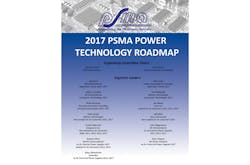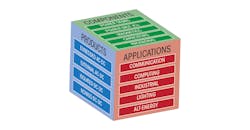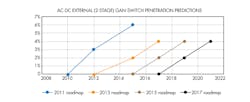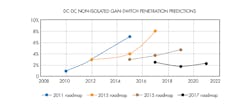Q&A: Power Technology Roadmap Co-Chairs Divulge Details Behind New Report
Download this article in PDF format.
Published every two years, the latest Power Technology Roadmap (PTR) report—a publication of the Power Sources Manufacturers Association (PSMA) (Fig. 1)—recently debuted at APEC 2017. To get some insights on the roadmap, Electronic Design talked with the co-chairs of the report, Conor Quinn from Artesyn Embedded Technologies and Dhaval Dalal from ON Semiconductor.
Does the focus of the report change with every edition? What is different about this report?
We don’t intentionally change the focus of the report, but it does evolve over time in a number of ways. The co-chairs and report leaders want the roadmap to reflect changes in the industry, and will add sections to the report as needed. When the report started, it was primarily a product report tracking the metrics associated with those products. In time, the importance of applications was recognized, so a section was added for these. Later, an emerging technologies section was added.
1. The latest Power Technology Roadmap (PTR) report launched at APEC 2017. (Courtesy of PSMA)
This year, we wanted to consolidate the discussion of components into a new section. This section addresses both passive and active devices; the discussion on active devices includes both the controllers and the switching devices.
The choice of webinars also helps set the tone of each edition. While we actively solicit contributions, these also tend to naturally track shifts in the industry. This is evidenced by the high percentage of webinars addressing wide-bandgap technologies over the last number of roadmap cycles.
In terms of methodology, how does PSMA identify trends in the semiconductor industry for the roadmap?
For a number of roadmap cycles, we’ve had a consistent methodology. Using the cube as a guide (Fig. 2), we aim to cover the relationships between product technology, applications, and component technologies.
2. This cube serves as a guide for the roadmap in covering relationships between product and component technology, and applications. (Courtesy of PSMA)
Early in the cycle, we form working groups that are responsible for each section of the report, or in the case of the product technology section, for a particular product type.
At the same time, we kick off the webinar series. The webinars come from a number of sources. PSMA’s technical committees contribute some of these, while others are proposed or solicited by the working group leaders. The co-chairs will also identify additional topics, some to cover missing items of interest and others to provide balance in number or perspective. The webinar content, both slides and recordings, are included in the final report.
Midway through the webinar series, we also survey our membership and the broader industry for their opinions on trends. The product technology working groups use this, along with their own expertise, to prepare a quantitative assessment of industry trends.
In parallel with this, other industry experts gather and write assessments of key applications and emerging technologies. These sections begin with a template that guides the authors to address market drivers, metrics, trends, and challenges as they apply to their particular section.
Had the roadmap changed much in the last two years? What technology advances are affecting the roadmap?
During our plenary presentation at APEC, we highlighted two key messages from the roadmap:
One is that “nothing has changed” in the sense that the traditional power-supply and power-converter spaces continue on their technology “treadmill.” In these applications, the technology is still focused on making the devices and circuits smaller and cheaper. We term this technology-responsive.
3. Predictions for AC-DC external GaN penetration into the market. (Courtesy of PSMA)
On the other hand, there was also a message of “everything is different.” Now, there are many applications where power electronics is shaping the technology, rather than just being responsive to it. This edition of the report had a high percentage of content dedicated to these applications and markets. Examples range from microwatts of power associated with energy harvesting through multi-kilowatts, and even megawatts, associated with alternative energy. Electrified and electric vehicles also fall into this category.
Shifting to discussion of component trends, the high level of interest continues in wide-bandgap (WBG) semiconductors. Past editions of the report addressed the technologies behind these, and this edition continues that trend. Since the last report was published, these technologies have moved into the commercialization stage and a number of devices are now available on the general market.
With this comes the pertinent question of the rate of adoption of the devices. The data collected during the publication of this report was compared with previous reports and presented at the plenary. In some segments, the data indicates that enthusiasm remains for short-term adoption, while in others, the benefits of WBG devices may not be sufficient to replace silicon devices. A couple of examples can be seen in Figures 3 and 4.
4. Predictions for DC-DC non-isolated GaN penetration into the market. (Courtesy of PSMA)
During your presentation at the plenary session, you talked about magnetics as the “elephant in the room.” Could you please expand your thoughts on the idea of the future of magnetics design?
In many ways, this ties to the discussion of WBG devices and their adoption rates. For a number of years, some in the industry have questioned whether magnetics would hold back the promise of increased switching frequencies that accompanied the commercial availability of gallium-nitride (GaN) and silicon-carbide (SiC) MOSFETs. Magnetic material improvements appeared incremental at best and there appeared to be a disconnect in expectations between the suppliers of these materials and the users, i.e. power-converter designers. This is what I meant by the “elephant in the room.”
But progress has been made in the last year or so. Much of this progress has been driven by the PSMA Magnetics Committee. Some of this progress is captured in the report, but readers should also be aware of an additional PSMA-sponsored magnetics workshop that was held in Tampa on the day before APEC started.
How do you envision the next PSMA power technology roadmap?
The next edition of the roadmap will be published in 2019, and we will begin the planning process in the next few months.
With the commercialization of WBG devices, we believe that the committee and readers will be very interested in evaluating the rate of adoption of these devices and whether related technologies such as magnetics and packaging, for example, will be a significant factor in the adoption cycle.
In terms of the report structure, we envision only minor changes. For example, we are considering the addition of a short synopsis of research activity at universities that have a focus on power conversion. Some of the quantitative tables also need to be refreshed, and we will look carefully at that. Some of the parameters tracked in those tables are no longer meaningful, while other parameters need to be added.
Outside of that, we expect the methodology and process to be the same as recent years.
What surprised you the most?
“Surprised” is probably too strong a word for those of us who actively monitor technology trends, but the degree to which there is strong bifurcation of the industry stood out. By this we mean the obvious divergence of the industry into the traditional technology-responsive segment (ac-dc power supplies and dc-dc converters) and the newer technology-shaping segments.
With power electronics at the core of these applications and markets, there comes an opportunity for the power-conversion industry to promote itself to the broader public and come out of the proverbial shadows.
About the Author
Maria Guerra
Power/Analog Editor
Maria Guerra is the Power/Analog Editor for Electronic Design. She is an Electrical Engineer with an MSEE from NYU Tandon School of Engineering. She has a very solid engineering background and extensive experience with technical documentation and writing. Before joining Electronic Design, she was an Electrical Engineer for Kellogg, Brown & Root Ltd (London. U.K.). During her years in the Oil and Gas Industry she was involved in a range of projects for both offshore and onshore designs. Her technical and soft skills bring a practical, hands-on approach to the Electronic Design team.





